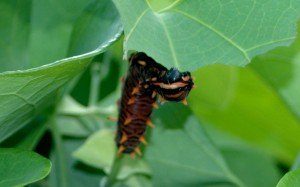You don’t have to travel far to see some amazing things. Take this morning, for instance. Marcella and I had planned carefully to be able to be at Yamato Scrub early in the morning, so we could give Eric a nice stroll, check up on the Least Grebes, and see what else might be seen at our local natural area. Things don’t always work out as planned, however…
We were hungrier than we’d anticipated, so we decided to stop for breakfast first. That meant I had to put my bike on top of the car, instead of just riding it to the scrub. Mission accomplished there. And, after a lovely breakfast at Tom Sawyer’s, I rode my bike up the road to the site, while Marcella and Eric drove in style. As I was pedaling, I realized that it was already pretty hot, and the sun was pretty strong. Not excellent strolling conditions.
What’s more, as I was coasting down the only kind of hill we have here in SoFla (freeway overpass bridges), I realized one more thing: in the scramble to get ready for breakfast, it seems that some people (it must have been really early on a Saturday morning) weren’t able to get the stroller, the camera, or the binoculars into the car. So the entire purpose of our expedition to the scrub was defeated. As soon as I rode up, we made the necessary adjustments to our traveling party’s comfort (Eric needed a change), and set sail for home.
And, as if to make up for it all, this afternoon, as I was taking care of some long-overdue gardening in the backyard, I ran across some very interesting things. Several generations of butterfly were present, as you can see in the gallery below:
no images were found
As I’ve mentioned elsewhere, Polydamas Swallowtail (Battus polydamus) butterflies are extremely hard to photograph. In the gallery above, you can see two of the best shots I’ve ever taken of this species. Granted, they were taken with my P5100, a point and wait camera — a very nice point-and-wait, but still… Even with the D70, though, I’ve had very little luck with these guys. I usually do a little bit better with their slower moving larval stage:

It’s hard to get an easier subject to photograph with almost any kind of camera than your friendly neighborhood caterpillar…
Some caterpillars in the garden, though, run into trouble:

I’m fairly sure that this unlucky larva was an Orange-barred sulphur (Phoebis philea); we see the adults all the time flying around our Desert Senna, and that is their larval food, according to my Minno, Butler, & Hall). Whatever its true identity, this one will never make that amazing metamorphosis from caterpillar to chrysalis. The ants swarming all over it will make good use of its stored protein for their own purposes, though. (According again to my Minno, “Eggs and young caterpillars may be eaten by ants attracted by nectar glands on the leaf petioles.”)
The moral of this story is that nature is where you find it. Planning is no guarantee of a successful trip, but if you’ve planted right, you might be able to recover!
Enjoy…
